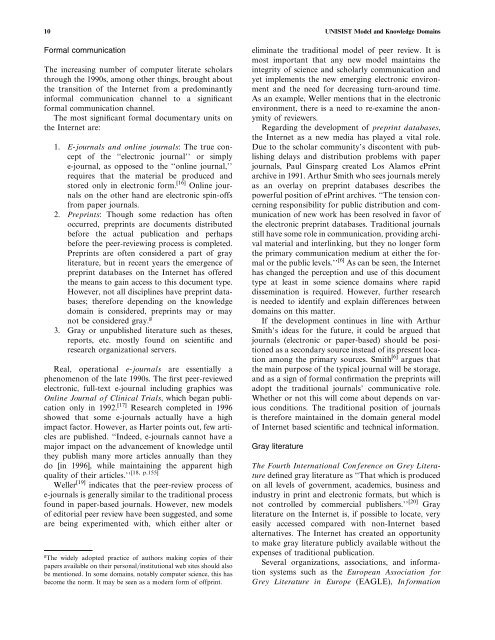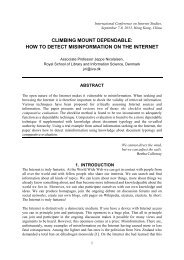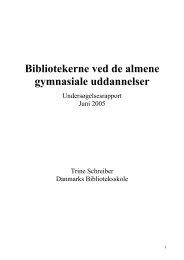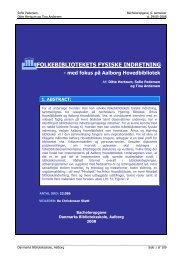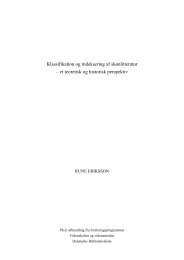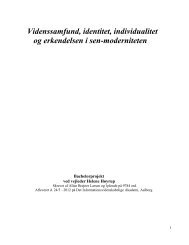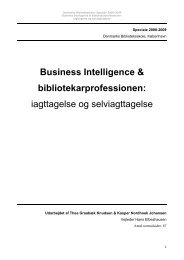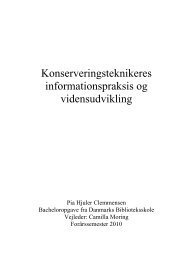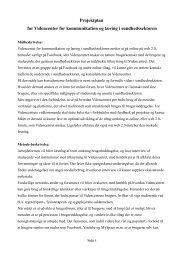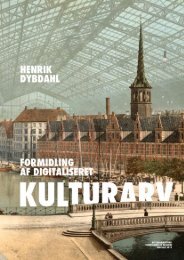UNISIST Model and Knowledge Domains
UNISIST Model and Knowledge Domains
UNISIST Model and Knowledge Domains
You also want an ePaper? Increase the reach of your titles
YUMPU automatically turns print PDFs into web optimized ePapers that Google loves.
10 <strong>UNISIST</strong> <strong>Model</strong> <strong>and</strong> <strong>Knowledge</strong> <strong>Domains</strong><br />
Formal communication<br />
The increasing number of computer literate scholars<br />
through the 1990s, among other things, brought about<br />
the transition of the Internet from a predominantly<br />
informal communication channel to a significant<br />
formal communication channel.<br />
The most significant formal documentary units on<br />
the Internet are:<br />
1. E-journals <strong>and</strong> online journals: The true concept<br />
of the ‘‘electronic journal’’ or simply<br />
e-journal, as opposed to the ‘‘online journal,’’<br />
requires that the material be produced <strong>and</strong><br />
stored only in electronic form. [16] Online journals<br />
on the other h<strong>and</strong> are electronic spin-offs<br />
from paper journals.<br />
2. Preprints: Though some redaction has often<br />
occurred, preprints are documents distributed<br />
before the actual publication <strong>and</strong> perhaps<br />
before the peer-reviewing process is completed.<br />
Preprints are often considered a part of gray<br />
literature, but in recent years the emergence of<br />
preprint databases on the Internet has offered<br />
the means to gain access to this document type.<br />
However, not all disciplines have preprint databases;<br />
therefore depending on the knowledge<br />
domain is considered, preprints may or may<br />
not be considered gray. g<br />
3. Gray or unpublished literature such as theses,<br />
reports, etc. mostly found on scientific <strong>and</strong><br />
research organizational servers.<br />
Real, operational e-journals are essentially a<br />
phenomenon of the late 1990s. The first peer-reviewed<br />
electronic, full-text e-journal including graphics was<br />
Online Journal of Clinical Trials, which began publication<br />
only in 1992. [17] Research completed in 1996<br />
showed that some e-journals actually have a high<br />
impact factor. However, as Harter points out, few articles<br />
are published. ‘‘Indeed, e-journals cannot have a<br />
major impact on the advancement of knowledge until<br />
they publish many more articles annually than they<br />
do [in 1996], while maintaining the apparent high<br />
quality of their articles.’’<br />
[18, p.155]<br />
Weller [19] indicates that the peer-review process of<br />
e-journals is generally similar to the traditional process<br />
found in paper-based journals. However, new models<br />
of editorial peer review have been suggested, <strong>and</strong> some<br />
are being experimented with, which either alter or<br />
g The widely adopted practice of authors making copies of their<br />
papers available on their personal=institutional web sites should also<br />
be mentioned. In some domains, notably computer science, this has<br />
become the norm. It may be seen as a modern form of offprint.<br />
eliminate the traditional model of peer review. It is<br />
most important that any new model maintains the<br />
integrity of science <strong>and</strong> scholarly communication <strong>and</strong><br />
yet implements the new emerging electronic environment<br />
<strong>and</strong> the need for decreasing turn-around time.<br />
As an example, Weller mentions that in the electronic<br />
environment, there is a need to re-examine the anonymity<br />
of reviewers.<br />
Regarding the development of preprint databases,<br />
the Internet as a new media has played a vital role.<br />
Due to the scholar community’s discontent with publishing<br />
delays <strong>and</strong> distribution problems with paper<br />
journals, Paul Ginsparg created Los Alamos ePrint<br />
archive in 1991. Arthur Smith who sees journals merely<br />
as an overlay on preprint databases describes the<br />
powerful position of ePrint archives. ‘‘The tension concerning<br />
responsibility for public distribution <strong>and</strong> communication<br />
of new work has been resolved in favor of<br />
the electronic preprint databases. Traditional journals<br />
still have some role in communication, providing archival<br />
material <strong>and</strong> interlinking, but they no longer form<br />
the primary communication medium at either the formal<br />
or the public levels.’’ [6] As can be seen, the Internet<br />
has changed the perception <strong>and</strong> use of this document<br />
type at least in some science domains where rapid<br />
dissemination is required. However, further research<br />
is needed to identify <strong>and</strong> explain differences between<br />
domains on this matter.<br />
If the development continues in line with Arthur<br />
Smith’s ideas for the future, it could be argued that<br />
journals (electronic or paper-based) should be positioned<br />
as a secondary source instead of its present location<br />
among the primary sources. Smith [6] argues that<br />
the main purpose of the typical journal will be storage,<br />
<strong>and</strong> as a sign of formal confirmation the preprints will<br />
adopt the traditional journals’ communicative role.<br />
Whether or not this will come about depends on various<br />
conditions. The traditional position of journals<br />
is therefore maintained in the domain general model<br />
of Internet based scientific <strong>and</strong> technical information.<br />
Gray literature<br />
The Fourth International Conference on Grey Literature<br />
defined gray literature as ‘‘That which is produced<br />
on all levels of government, academics, business <strong>and</strong><br />
industry in print <strong>and</strong> electronic formats, but which is<br />
not controlled by commercial publishers.’’ [20] Gray<br />
literature on the Internet is, if possible to locate, very<br />
easily accessed compared with non-Internet based<br />
alternatives. The Internet has created an opportunity<br />
to make gray literature publicly available without the<br />
expenses of traditional publication.<br />
Several organizations, associations, <strong>and</strong> information<br />
systems such as the European Association for<br />
Grey Literature in Europe (EAGLE), Information


